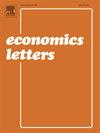工资粘性和货币政策传导的行业异质性
IF 1.8
4区 经济学
Q2 ECONOMICS
引用次数: 0
摘要
众所周知,在价格粘性中引入部门异质性会放大标准新凯恩斯模型中的货币非中性(Carvalho, 2006)。然而,人们对异质性在工资粘性中的作用关注较少。使用行业层面的数据,我记录了在3位数的NAICS水平上,工资和价格刚性之间的统计显著负相关为-0.27。然后,我开发了一个包含工资和价格刚性异质性的多部门新凯恩斯主义模型。该模型表明,根据行业工资与价格刚性之间的相关性,相对于只有异质性价格刚性的基准经济体,对货币冲击的累积实际反应要么被放大,要么被抑制。具体来说,部门工资和价格刚性之间的完全正相关关系将累计实际反应放大了14%,而完全负相关关系将其减少了约9%。然而,在对53个部门的美国经济进行实证校准的模型中,工资刚性异质性的总体影响是有限的,因为观察到的弱相关性和大型、中等刚性部门的影响抑制了潜在的传导渠道。本文章由计算机程序翻译,如有差异,请以英文原文为准。
Sectoral heterogeneity in wage stickiness and monetary policy transmission
It is well known that introducing sectoral heterogeneity in price stickiness amplifies monetary non-neutrality in standard New Keynesian models (Carvalho, 2006). Yet, less attention has been paid to the role of heterogeneity in wage stickiness. Using industry-level data, I document a statistically significant negative correlation of –0.27 between wage and price rigidity at the 3-digit NAICS level. I then develop a multi-sector New Keynesian model that incorporates heterogeneity in both wage and price rigidities. The model shows that, depending on the correlation between sectoral wage and price rigidities, the cumulative real response to a monetary shock can either be amplified or dampened relative to a benchmark economy with only heterogeneous price rigidity. Specifically, a perfectly positive correlation between sectoral wage and price rigidities amplifies the cumulative real response by up to 14 percent, whereas a perfect negative correlation reduces it by approximately 9 percent. However, in the model empirically calibrated to the 53-sector U.S. economy, the aggregate impact of wage rigidity heterogeneity is limited, as the weak observed correlation and the influence of large, moderately rigid sectors mute the underlying transmission channel.
求助全文
通过发布文献求助,成功后即可免费获取论文全文。
去求助
来源期刊

Economics Letters
ECONOMICS-
CiteScore
3.20
自引率
5.00%
发文量
348
审稿时长
30 days
期刊介绍:
Many economists today are concerned by the proliferation of journals and the concomitant labyrinth of research to be conquered in order to reach the specific information they require. To combat this tendency, Economics Letters has been conceived and designed outside the realm of the traditional economics journal. As a Letters Journal, it consists of concise communications (letters) that provide a means of rapid and efficient dissemination of new results, models and methods in all fields of economic research.
 求助内容:
求助内容: 应助结果提醒方式:
应助结果提醒方式:


